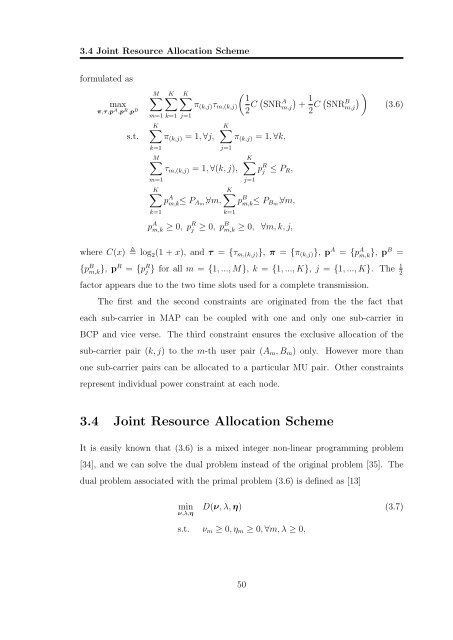Resource Allocation in OFDM Based Wireless Relay Networks ...
Resource Allocation in OFDM Based Wireless Relay Networks ...
Resource Allocation in OFDM Based Wireless Relay Networks ...
You also want an ePaper? Increase the reach of your titles
YUMPU automatically turns print PDFs into web optimized ePapers that Google loves.
3.4 Jo<strong>in</strong>t <strong>Resource</strong> <strong>Allocation</strong> Scheme<br />
formulated as<br />
max<br />
π,τ ,p A ,p R ,p B<br />
s.t.<br />
M<br />
∑<br />
K∑<br />
m=1 k=1 j=1<br />
K∑<br />
( 1<br />
π (k,j) τ m,(k,j)<br />
2 C ( SNR A m,j<br />
K∑<br />
π (k,j) = 1, ∀j,<br />
k=1<br />
K∑<br />
π (k,j) = 1, ∀k,<br />
j=1<br />
M∑<br />
τ m,(k,j) = 1, ∀(k, j),<br />
m=1<br />
K∑<br />
p A m,k≤ P Am ,∀m,<br />
k=1<br />
K∑<br />
p R j ≤ P R ,<br />
j=1<br />
K∑<br />
p B m,k≤ P Bm ,∀m,<br />
k=1<br />
p A m,k ≥ 0, p R j ≥ 0, p B m,k ≥ 0, ∀m, k, j,<br />
) 1 +<br />
2 C ( ) )<br />
SNR B m,j (3.6)<br />
where C(x) log 2 (1 + x), and τ = {τ m,(k,j) }, π = {π (k,j) }, p A = {p A m,k }, pB =<br />
{p B m,k }, pR = {p R j } for all m = {1, ..., M}, k = {1, ..., K}, j = {1, ..., K}. The 1 2<br />
factor appears due to the two time slots used for a complete transmission.<br />
The first and the second constra<strong>in</strong>ts are orig<strong>in</strong>ated from the the fact that<br />
each sub-carrier <strong>in</strong> MAP can be coupled with one and only one sub-carrier <strong>in</strong><br />
BCP and vice verse. The third constra<strong>in</strong>t ensures the exclusive allocation of the<br />
sub-carrier pair (k, j) to the m-th user pair (A m , B m ) only. However more than<br />
one sub-carrier pairs can be allocated to a particular MU pair. Other constra<strong>in</strong>ts<br />
represent <strong>in</strong>dividual power constra<strong>in</strong>t at each node.<br />
3.4 Jo<strong>in</strong>t <strong>Resource</strong> <strong>Allocation</strong> Scheme<br />
It is easily known that (3.6) is a mixed <strong>in</strong>teger non-l<strong>in</strong>ear programm<strong>in</strong>g problem<br />
[34], and we can solve the dual problem <strong>in</strong>stead of the orig<strong>in</strong>al problem [35]. The<br />
dual problem associated with the primal problem (3.6) is def<strong>in</strong>ed as [13]<br />
m<strong>in</strong><br />
ν,λ,η<br />
D(ν, λ, η) (3.7)<br />
s.t. ν m ≥ 0, η m ≥ 0, ∀m, λ ≥ 0,<br />
50

















